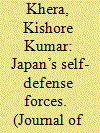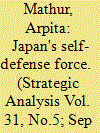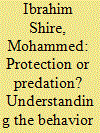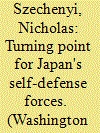| Srl | Item |
| 1 |
ID:
163383


|
|
|
|
|
| Summary/Abstract |
Japan banks heavily on her security alliance with the United States (US) to ensure availability of requisite military capability in the region. China’s economic and military capabilities have grown in the last two decades, closing the gap with the US. With diminishing differential, especially with respect to China, the US’ deterrence power has gradually declined. Under these conditions, Japan has to develop Self-Defense Forces (SDF) capabilities to ensure that it, in combination with its alliance partner, the US, is able to meet national security challenges. In a major shift in security policy, on 9 January 2007 Japan’s Parliament approved the upgradation of Defense Agency/SDF to a full-fledged ministry. However, the changes in the SDF, especially in its doctrine and roles, have been gradual. Till SDF graduates to have an offensive capability that can deter capably, the US will continue to be a key player in Japan’s security milieu.
|
|
|
|
|
|
|
|
|
|
|
|
|
|
|
|
| 2 |
ID:
079616


|
|
|
|
|
| Publication |
2007.
|
| Summary/Abstract |
The Self-Defense Forces (SDF) are one of the variables of the distinctly pacifist security policy Japan has followed ever since the end of the war. Japan's ongoing 'normalisation' involves an enhancement of the role and functions of these forces. Although the SDF's role has considerably increased in the past decade, it cannot be characterised as Japan's remilitarisation because of strong domestic and external checks. The shift in the SDF's role has to be seen in the larger context of fundamental changes in regional security in East Asia and Tokyo's intent to broaden its regional and global security profile.
|
|
|
|
|
|
|
|
|
|
|
|
|
|
|
|
| 3 |
ID:
184184


|
|
|
|
|
| Summary/Abstract |
During civil wars, some communities raise self-defense militias to protect themselves from insurgent predation, but these militias can end up mutating into predatory organizations. The extant literature has focused chiefly on the predatory propensity of state-created self-defense militias and has mostly overlooked why some community-created self-defense militias segue into predatory organizations while others eschew predation altogether. This study explains this phenomenon, drawing on in-depth interviews with active members of two community-created self-defense militias (Ahlu Sunna Waljama’a and Macawiisley) in Somalia. In doing so, two sequential mechanisms (sponsorship and mobility) that determine the propensity of predatory behavior are introduced. Self-defense militias that conduct offensive operations engage in predatory behavior, irrespective of whether they are sponsored locally or have external patrons. Externally sponsored self-defense militias that engage in offensive operations attract opportunistic recruits and become motivated by material benefits, while community-sponsored self-defense militias that conduct offensive operations instrumentalize their position to settle old scores against rival communities. By contrast, self-defense militias that restrict their operations to defensive activities typically recruit dedicated homegrown members, and are regulated by community-managed accountability mechanisms that prevent predatory and abusive behavior. This community control remains crucial for defensive self-defense militias, who must balance external patrons’ strategic aims with their local objectives.
|
|
|
|
|
|
|
|
|
|
|
|
|
|
|
|
| 4 |
ID:
137256


|
|
|
|
|
| Summary/Abstract |
From Iraq to the Gulf of Aden and the South Pacific, this paper evaluates how far theoretical ideas about smart power manifest in operational missions of the Japan Self-Defense Forces (JSDF). To function within a ‘smart’ power context, this paper suggests that JSDF operates in ‘assisting’ mode, rather than the ‘threatening’ behavior of ‘hard’ power. JSDF also deployed alongside other Japanese ‘soft’ power tools – diplomatic, cultural, developmental, and NGOs, using tailored programs for different cultural and geographical contexts. Given constitutional constraints and public sensitivity towards coercive force, JSDF missions could be integrated more into a ‘whole-of-government’ approach advancing foreign policy goals through ‘smart power’.
|
|
|
|
|
|
|
|
|
|
|
|
|
|
|
|
| 5 |
ID:
073811


|
|
|
|
|
| Publication |
2006.
|
| Summary/Abstract |
The next Japanese government can continue to articulate a progressive vision for its Self-Defense Forces, remind the Japanese people of the strategic impact of their expanded roles and missions, and potentially provide a turning point in developing a contemporary Japanese security policy.
|
|
|
|
|
|
|
|
|
|
|
|
|
|
|
|